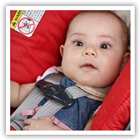You are here
Baby At Play
Passenger Safety for Babies
 Car Seats
Car Seats
Your baby is going places. Here are tips on how to get there safely in the right car seat. The most important tip: Keep your child rear facing for as long as possible. Stay rear facing until your child has outgrown the car seat by weight or height. Many children will be able to take advantage of this safer ride beyond age 2 or even 3.
Types of Rear-Facing Car Seats
There are three types of rear-facing car seats.
- Rear-Facing Only Seat. People often buy this type of seat because it is portable. Most, but not all, can be used in strollers that are sold with the car seat or those recommended by the manufacturer. Caregivers can also purchase extra bases for the car seat so that it can be used in several cars.
- Convertible Car Seat. This seat is larger and stays in the car. It can be used rear facing until your child is 2 years or more. After that, it can change to a forward-facing seat. It generally has higher weight or height limits, so it will last longer than the rear-facing only seat.
- 3-in-1 car seat. This seat also stays in the car. You can use it rear facing, forward facing, and then later, as a booster seat.
Installing Rear-Facing Car Seats
- Install your rear-facing car seat in a back seat. You can use either a locked seat belt or lower anchor attachments. Either works, but don’t use both at the same time. This video will show you how to install your rear-facing car seat.
- Check the car seat’s angle indicator. (It is on the seat.) Make sure the recline angle is correct. The recline angle is critical for infants who can’t yet lift their heads to breathe. Check the car seat manual and labels for more help.
- Get a snug fit. Make sure the car seat is snug enough to pass the Inch Test. A properly-installed car seat should not move more than one inch side to side or front to back when pulled at the car seat’s belt path near the baby’s feet, not near the head. Check out the Inch Test video.
Four Steps to the Right Fit for Baby’s Car Seat
- Place your baby in the seat. Your baby’s back and bottom should be flat against the car seat. Do not put anything behind or underneath them, such as a blanket or pillow.
- Check the harness straps. Make sure that the harness straps come through the car seat’s slots at or just below your baby’s shoulders.
- Buckle and tighten the harness so it is snug. Do the Pinch Test to make sure you cannot pinch the harness strap at your baby’s shoulders. You will need to loosen and tighten the harness each time you put your child in the car seat to get a snug fit. Check out the Pinch Test video.
- Position the chest clip. It needs to be level with your baby’s armpits.
When to Change to the Next Car Seat
- Don’t be in a hurry! The safest car seat for children is a rear-facing one. Riding in a rear-facing car seat will help protect your child’s head, neck and spine in a crash. You may have to move your child from a smaller rear-facing-only car seat to a bigger convertible car seat or a 3-in-1 car seat installed in the rear-facing position.
- Check the label. Your child will be ready for a larger, rear-facing car seat when she passes the weight or height limit on the car seat label or when her head is within one inch of the top of the car seat.
- Long legs? Older children with longer legs can stay in a rear-facing car seat and comfortably cross their legs. All children, even those with special healthcare needs, follow the same rules for staying safe in the car.


